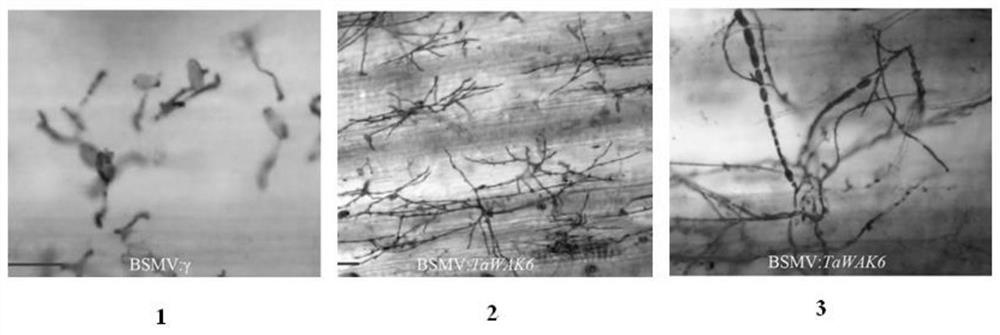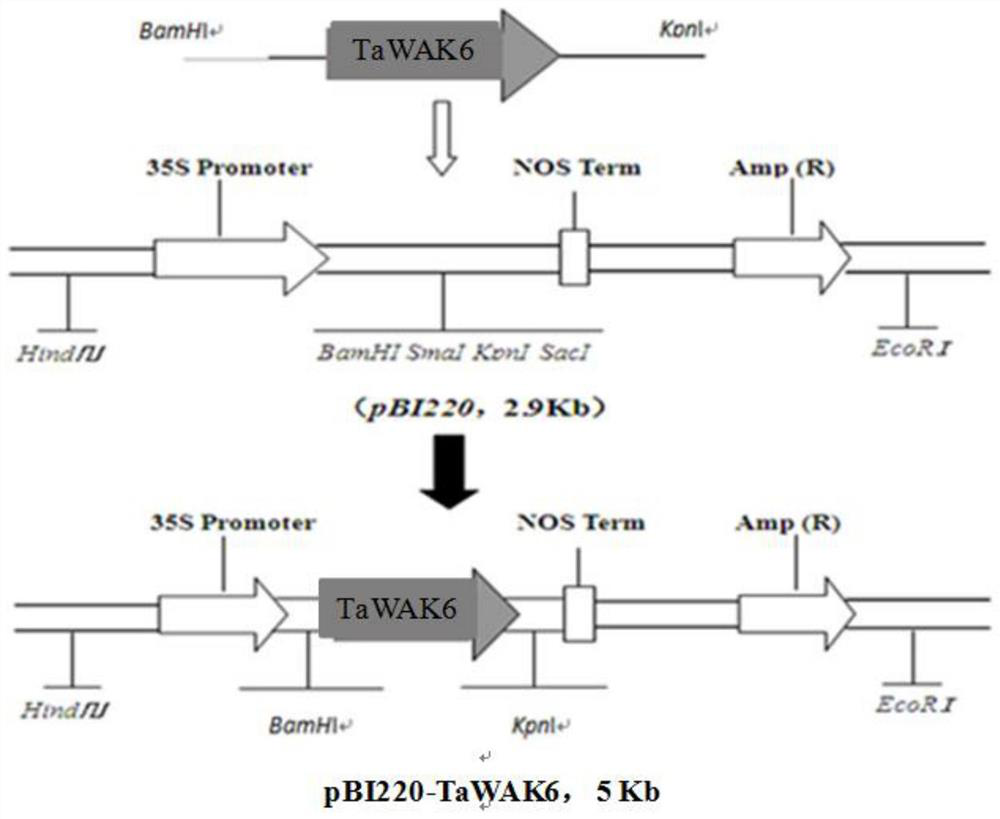A wheat cell wall-associated receptor protein kinase gene and its expression vector and application
A technology of receptor protein and expression vector, applied in the field of genetic engineering to achieve the effect of improving resistance
- Summary
- Abstract
- Description
- Claims
- Application Information
AI Technical Summary
Problems solved by technology
Method used
Image
Examples
Embodiment 1
[0024] Example 1 Cloning of a cell wall-associated receptor protein kinase gene TaWAK6 in Nannong 9918
[0025] Nannong 9918 is a wheat variety with broad-spectrum powdery mildew resistance gene Pm21 bred by Nanjing Agricultural University (publicly known and public, reference: Chen Peidu, Zhang Shouzhong, Wang Xiu'e, Wang Suling, Zhou Bo, Feng Yigao, Liu Dajun. High yield against powdery mildew) New wheat variety Nannong 9918. Journal of Nanjing Agricultural University, 2002, 25(4): 1438-1444), SM-1 is a powdery mildew-susceptible mutant obtained by Nanjing Agricultural University after treating Nannong 9918 with EMS (known and public, References: Xing,P.Hu,J.Liu,K.Witek,S.Zhou,J.Xu,W.Zhou,L.Gao,Z.Huang,R.Zhang,X.Wang,P.Chen,H .Wang,J.D.G.Jones,M.Karafiátová,J.Vrána,J. J. Y. Tian, Y. Wu, A. Cao, Pm21 from Haynaldia villosa encodes a CC-NBS-LRR protein conferring powderymildew resistance in wheat, Mol. Plant (2018) doi: 10.1016 / j.molp.2018.02.013.). In order to screen t...
Embodiment 2
[0028] Example 2 Using BMSV-VIGS system to study the powdery mildew resistance of TaWAK6
[0029] Virus-Induced Gene Silencing (VIGS) means that after a virus carrying a target gene segment infects a plant, it can induce silencing of the plant's endogenous gene and cause phenotypic changes, and then study the function of the target gene according to the phenotypic variation. Compared with traditional gene function analysis methods, VIGS can rapidly silence and functionally identify target genes to overcome functional duplications. The Barley Stripe Mosaic Virus (BSMV) has been engineered for gene silencing and functional validation in wheat (References: Zhou H, Li S, Deng Z, Wang X, Chen T, Zhang J, Chen S , Ling H, Zhang A, Wang D, Zhang X (2007) Molecular analysis of three new receptor-like kinase genes from hexaploid wheat and evidence for their participation in the wheat hypersensitive response to stripe rustfungus infection. Plant J 52:420–434).
[0030] Amplification of...
Embodiment 3
[0034] Example 3 Construction of TaWAK6 gene transient expression vector
[0035]Using powdery mildew-induced TaWAK6 gene cDNA cloned from Nannong 9918 as a template, primer pairs TaWAK6-BamHI-F (AGTCCGGAGCTAGCTCTAGAATGTCACAAGCAAAGCTCATC, SEQ ID NO.8) and TaWAK6-KpnI-R (CCCTTGCTCACCATGGATCCTCTAGGAATTTCAGATGATTGG, SEQ ID NO.9) were used as templates. PCR amplification was performed, and the amplified fragments were recovered. PCR program: 2 μl plasmid template (100ng / ul), 2 μl P3 primer (10 μM), 2 μl P4 primer, 25 μl Phanta Max buffer (2×), 2 μl dNTP Mix (10 mM), 1 μl Phanta Max Super-Fidelity DNA polymerase ( 1 U / μl) (Vazyme, China), add water to 50 μl. PCR reaction conditions: pre-denaturation at 95°C for 3 minutes; 95°C for 15 seconds, 58°C for 15 seconds, 72°C for 30 seconds, 35 cycles; extension at 72°C for 5 minutes. PCR products were subjected to 1.2% agarose gel electrophoresis to detect the specificity and size of the amplified band, and the specific amplified band (...
PUM
 Login to View More
Login to View More Abstract
Description
Claims
Application Information
 Login to View More
Login to View More - R&D
- Intellectual Property
- Life Sciences
- Materials
- Tech Scout
- Unparalleled Data Quality
- Higher Quality Content
- 60% Fewer Hallucinations
Browse by: Latest US Patents, China's latest patents, Technical Efficacy Thesaurus, Application Domain, Technology Topic, Popular Technical Reports.
© 2025 PatSnap. All rights reserved.Legal|Privacy policy|Modern Slavery Act Transparency Statement|Sitemap|About US| Contact US: help@patsnap.com



